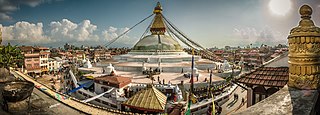Boudhanath, The World Heritage Sites Of Nepal

Boudhanath Panorama
| |
| Basic information | |
|---|---|
| Location | Kathmandu, Nepal |
| Affiliation | Buddhism |
| Architectural description | |
| Architectural type | Stupa |
| Specifications | |
| Height (max) | 36 metres (118 ft)[1] |
| Official name: Kathmandu Valley | |
| Type | Cultural |
| Criteria | iii, iv, vi |
| Designated | 1979 (3rd session) |
| Reference no. | 121 |
| State Party | |
Boudhanath (also referred to as boudha, bouddhanath or baudhanath or the khāsa caitya) is a stupa in kathmandu, nepal. it is referred to as khāsti in nepal bhasa, jyarung khashor in tibetan language (tibetan: བྱ་རུང་ཁ་ཤོར། wylie: bya rung kha shor) or as bauddha with the aid of audio system of nepali.placed about eleven km (6.8 mi) from the middle and northeastern outskirts of kathmandu, the stupa's massive mandala makes it certainly one of the biggest spherical stupas in Nepal.
the buddhist stupa of boudhanath dominates the skyline. the historical stupa is considered one of the biggest in the world. the influx of large populations of refugees from tibet has visible the construction of over 50 tibetan gompas (monasteries) round boudhanath. as of 1979, boudhanath is a unesco international historical past web page. together with swayambhunath, it's far one of the most popular traveler websites within the kathmandu location.
the buddhist stupa of boudhanath dominates the skyline. the historical stupa is considered one of the biggest in the world. the influx of large populations of refugees from tibet has visible the construction of over 50 tibetan gompas (monasteries) round boudhanath. as of 1979, boudhanath is a unesco international historical past web page. together with swayambhunath, it's far one of the most popular traveler websites within the kathmandu location.
The Stupa is on the ancient trade route from Tibet which enters the Kathmandu Valley by the village of Sankhu in the northeast corner, passes by Boudnath Stupa to the ancient and smaller stupa of Cā-bahī (often called 'Little Boudnath'). It then turns directly south, heading over the Bagmati river to Patan - thus bypassing the main city of Kathmandu (which was a later foundation).Tibetan merchants have rested and offered prayers here for many centuries. When refugees entered Nepal from Tibet in the 1950s, many decided to live around Boudhanath. The Stupa is said to entomb the remains of















0 comments :